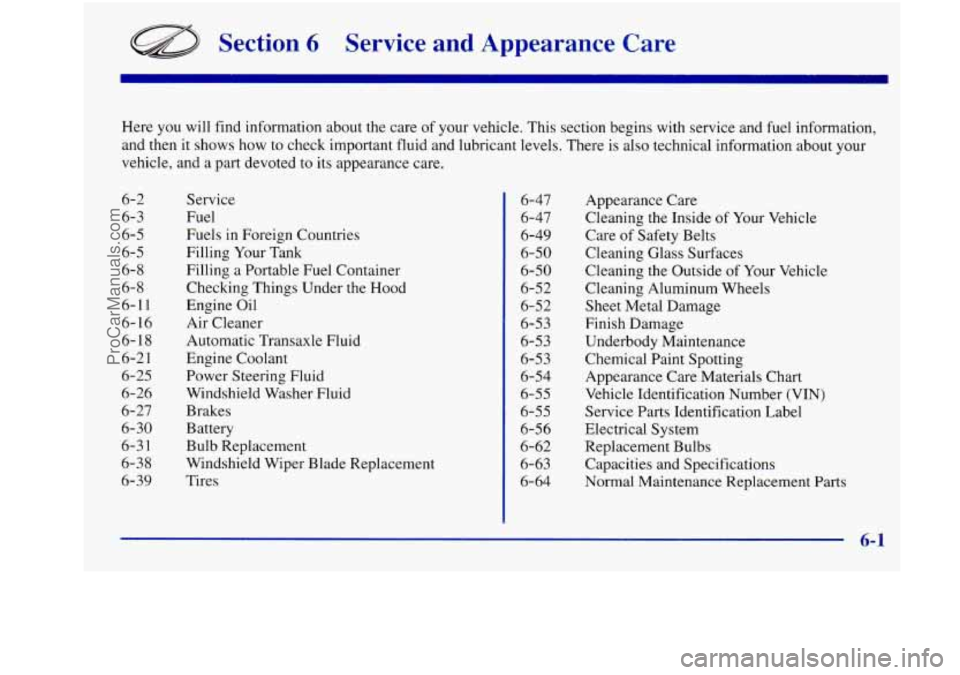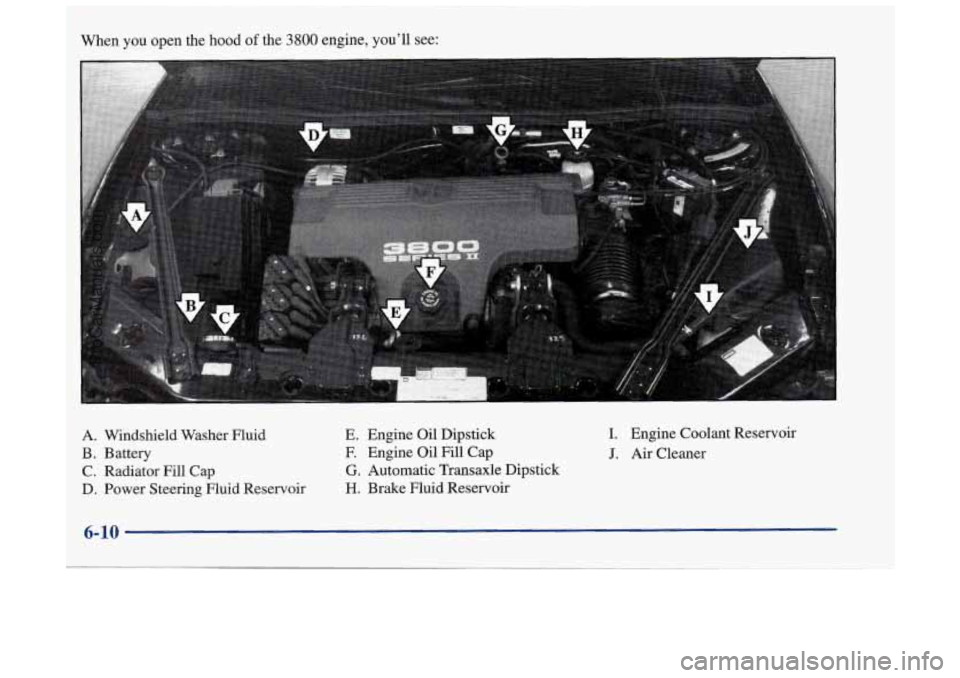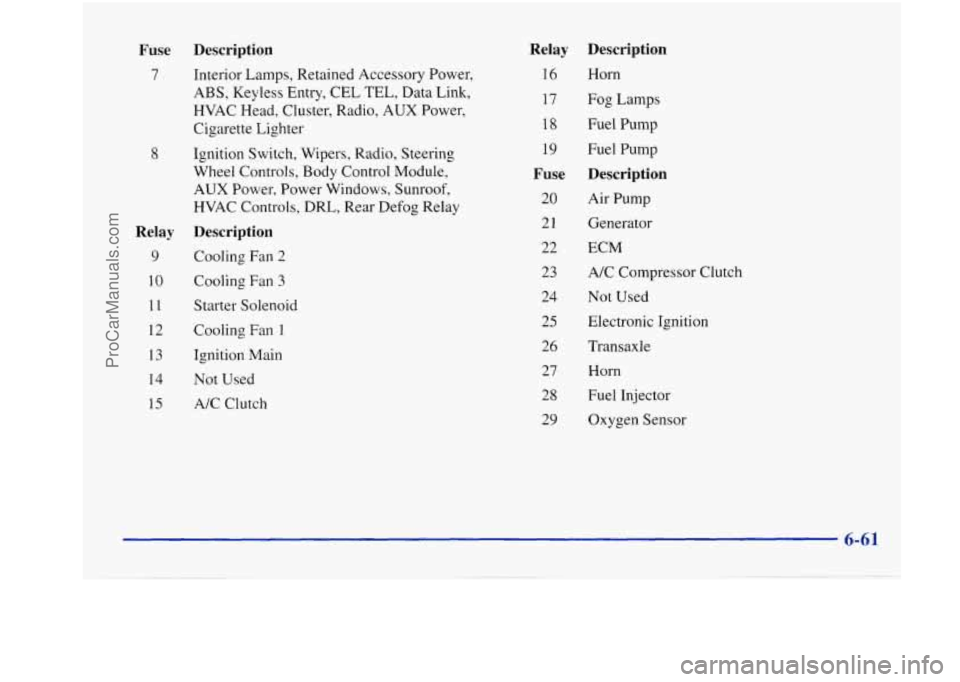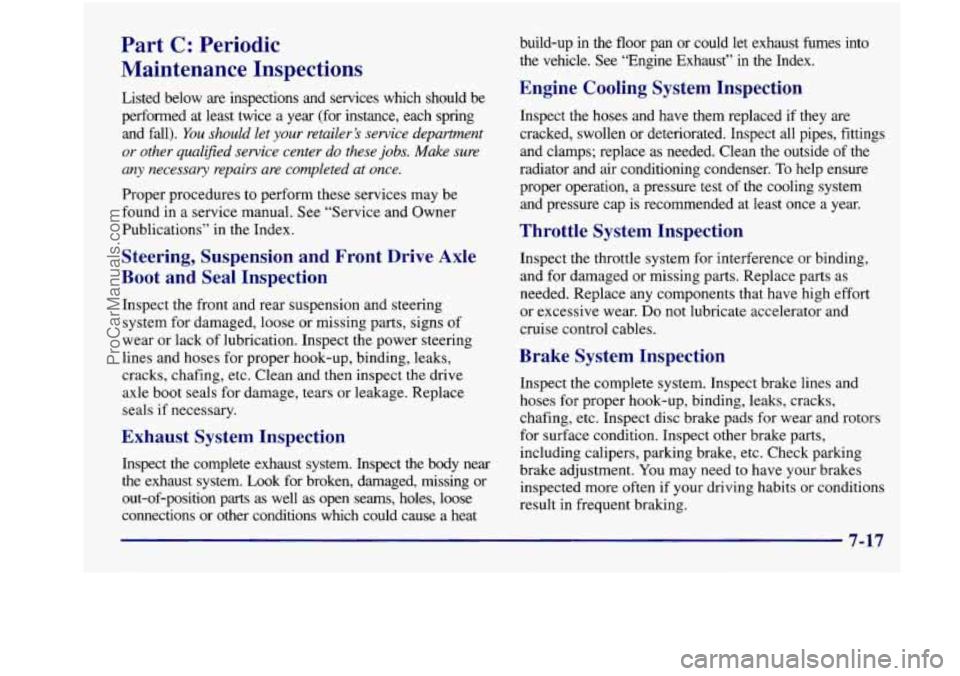power steering OLDSMOBILE INTRIGUE 1998 Owners Manual
[x] Cancel search | Manufacturer: OLDSMOBILE, Model Year: 1998, Model line: INTRIGUE, Model: OLDSMOBILE INTRIGUE 1998Pages: 340, PDF Size: 17.93 MB
Page 61 of 340

Section 2 Features and Controls
Here you can learn about the many standard and optional features on your vehicle, and information on starting,
shifting and braking. Also explained are the instrument panel and the warning systems that tell you if everything is
working properly
-- and what to do if you have a problem.
2-2
2-4
2-8
2-
13
2- 14
2- 14
2- 15
2-
16
2- 17
2-18
2-20
2-24
2-25
2-27 Keys
Door Locks
Keyless Entry System
Trunk
Theft
Passlock@
New Vehicle “Break-In”
Ignition Positions Starting Your Engine
Engine Coolant Heater (If Equipped)
Automatic Transaxle Operation
Parking Brake
Shifting Into PARK
(P)
Shifting Out of PARK (P) 2-27
2-28
2-28
2- 29
2-30
2-3
1
2-38
2-40
2-43
2-46
2-49
2-50 2-55 Parking Over Things That Burn
Engine Exhaust
Running Your Engine While You’re Parked
Windows Tilt Steering Wheel
Turn Signal/Multifunction Lever
Exterior Lamps
Interior
Lamps
Mirrors
Storage Compartments
Power Sunroof (If Equipped)
Instrument Panel
-- Your Information System
Warning Lights, Gages and Indicators
2-1
ProCarManuals.com
Page 151 of 340

Audio Steering Wheel Controls
(If Equipped)
If your vehicle has this
feature, you can control
certain radio functions
using the buttons
on your
steering wheel.
VOL: Press the up or down arrow to increase or
decrease volume.
SEEK: Press this button to tune to a higher radio
station. When playing a cassette tape or compact disc,
press
SEEK to hear the next selection. There must be
at least a three-second gap between selections on a
cassette tape.
PROG: Press this button to tune in a higher preset radio
station. When playing a cassette tape, press
PROG to
hear the other side of a tape that is playing. When using
the
CD changer, this button will seek the next selection.
Understanding Radio Reception
AM
The range for most AM stations is greater than for FM,
especially at night. The longer range, however, can
cause stations to interfere with each other. AM can pick
up noise from things like storms and power lines.
Try
reducing the treble to reduce this noise if you ever get it.
FM Stereo
FM stereo will give you the best sound, but FM signals
will reach only about 10 to
40 miles (16 to 65 km). Tall
buildings
or hills can interfere with FM signals, causing
the sound to come and
go.
3-25
ProCarManuals.com
Page 165 of 340

Steering
Power Steering
If you lose power steering assist because the engine
stops or the system
is not functioning, you can steer
but it will take much more effort.
Magnetic Speed Sensitive Steering
This steering system provides lighter steering effort
for parking and when driving at speeds below
20 mph (32 km/h). Steering effort will increase at
higher speeds for improved road
feel.
Steering Tips
Driving on Curves
It’s important to take curves at a reasonable speed.
A lot of the “driver lost control” accidents mentioned
on the news happen on curves. Here’s why:
Experienced driver or beginner, each
of us is subject to
the same laws of physics when driving on curves. The
traction
of the tires against the road surface makes it
possible for the vehicle to change its path when you turn
the front wheels.
If there’s no traction, inertia will keep
the vehicle going
in the same direction. If you’ve ever
tried
to steer a vehicle on wet ice, you’ll understand this. The
traction you can get in a curve depends on the
condition of
your tires and the road surface, the angle at
which the curve is banked, and your speed. While you’re
in
a curve, speed is the one factor you can control.
Suppose you’re steering through a sharp curve. Then you
suddenly accelerate. Both control systems
-- steering and
acceleration
-- have to do their work where the tires meet
the road. Adding the sudden acceleration can demand
too
much of those places. You can lose control.
What should you do if this ever happens? Ease up on the
accelerator pedal, steer the vehicle the way you want it
to go, and slow down.
Speed limit signs near curves warn that you should
adjust your speed. Of course, the posted speeds are
based on good weather and road conditions. Under less
favorable conditions you’ll want to
go slower.
If you need to reduce your speed as you approach a
curve, do it before you enter the curve, while your front
wheels are straight ahead.
Try
to adjust your speed so you can “drive” through the
curve. Maintain a reasonable, steady speed. Wait
to
accelerate until you are out of the curve, and then
accelerate gently into the straightaway.
ProCarManuals.com
Page 229 of 340

Section 6 Service and Appearance Care
Here you will find information about the care of your vehicle. This section begins with service and fuel information,
and then it shows how
to check important fluid and lubricant levels. There is also technical information about your
vehicle, and a part devoted to its appearance care.
6-2 Service
6-3 Fuel
6-5 Fuels in Foreign Countries
6-5 Filling Your Tank
6-
8 Filling a Portable Fuel Container
6-
8 Checking Things Under the Hood
6-1 1 Engine Oil
6-
16 Air Cleaner
6-18 Automatic Transaxle Fluid
6-2
1 Engine Coolant
6-25 Power Steering Fluid
6-26 Windshield Washer Fluid
6- 27 Brakes
6-30 Battery
6-38 Windshield Wiper Blade Replacement
6-3
1 Bulb Replacement
6-39 Tires 6-47
6-47
6-49
6-50
6-50
6-52
6-52
6-53
6-53
6-53
6-54
6-55
6-55
6-56
6-62
6-63
6-64 Appearance
Care
Cleaning the Inside of Your Vehicle
Care of Safety Belts
Cleaning Glass Surfaces
Cleaning the Outside of Your Vehicle
Cleaning Aluminum Wheels
Sheet Metal Damage
Finish Damage
Underbody Maintenance Chemical Paint Spotting
Appearance Care Materials Chart
Vehicle Identification Number (VIN)
Service Parts Identification Label
Electrical System
Replacement Bulbs Capacities and Specifications
Normal Maintenance Replacement
Parts
6-1
ProCarManuals.com
Page 238 of 340

I. Engine Coolant Reservoir
J. Air Cleaner
Windshield
Washer Fluid
Battery
Radiator Fill Cap
Power Steering Fluid Reservoir E.
Engine Oil Dipstick F. Engine Oil Fill Cap
G. Automatic Transaxle Dipstick
H. Brake Fluid Reservoir
A.
B.
C.
D.
6-10
ProCarManuals.com
Page 253 of 340

Power Steering Fluid
When to Check Power Steering Fluid
It is not necessary to regularly check power steering
fluid unless you suspect there is a leak in the system or
you hear an unusual noise. A fluid loss
in this system
could indicate
a problem. Have the system inspected
and repaired.
How To Check Power Steering Fluid
When the engine compartment is cool, wipe the cap and
the top
of the reservoir clean, then unscrew the cap and wipe the
dipstick with a clean rag. Replace the cap and
completely tighten it. Then remove the cap again and
look at the fluid level on the dipstick.
The level should be at the
FULL COLD mark. If
necessary, add only enough fluid to bring the level up
to the mark.
What to Use
To determine what kind of fluid to use, see
“Recommended Fluids and Lubricants” in
the Index.
Always use the proper fluid. Failure to use the proper
fluid can cause leaks and damage hoses and seals.
ProCarManuals.com
Page 287 of 340

Fuse
STOP LAMPS
Description
Stoplamps Switch
DOOR LOCKS Door Lock Relays (Internal to
Body Control Module) and
External Driver Door Lock Relay
POWER
MIRRORS
RED STRG
WHL ILLUM
FRT PRK LPS,
FOG LAMPS
TAIL LAMPS,
LIC LAMPS Left-hand
and Right-hand
Power Mirrors
Steering Wheel Radio Switch
Illumination
PARK LPS
-- Front Parking
Lamps, Sidemarker Lamps,
Fog lamps
Taillamps, License Lamps, Rear
Sidemarker Lamps, Rear
Sidemarker Lamps
Fuse
PANEL
DIMMING
WIPER
POWER DROP
RADIO, CRUISE
Circuit Breaker
PWR mows,
PWR SUNROOF
REAR DEFOG
POWER SEATS
Description
Dimmable Instrument
Panel Lamps
Wiper Switch
Power Drop
Radio, Steering Wheel Radio
Controls, Cruise Control Switches
Description
Power Windows, Power Sunroof
Rear Defog
Power Seats, Fuel Door Relay
6-59
ProCarManuals.com
Page 289 of 340

Fuse Description
7 Interior Lamps, Retained Accessory Power,
ABS, Keyless Entry, CEL TEL, Data Link,
HVAC Head, Cluster, Radio, AUX Power,
Cigarette Lighter
8 Ignition Switch, Wipers, Radio, Steering
Wheel Controls, Body Control Module,
AUX Power, Power Windows, Sunroof,
HVAC Controls, DRL, Rear Defog Relay
Relay Description
9 Cooling Fan 2
10 Cooling Fan 3
11 Starter Solenoid
12 Cooling Fan 1
13 Ignition Main
14 Not Used
15 A/C Clutch
Relay
16
17
18
19
Fuse
20
21
22
23
24
25
26
27
28
29
Description
Horn
Fog Lamps Fuel Pump
Fuel Pump
Description
Air Pump
Generator
ECM A/C Compressor Clutch
Not Used
Electronic Ignition
Transaxle
Horn Fuel Injector
Oxygen Sensor
ProCarManuals.com
Page 309 of 340

Part C: Periodic
Maintenance Inspections
Listed below are inspections and services which should be
performed at least twice a year (for instance, each spring
and fall).
You should let your retailer’s service department
or other qualiJied service center do these jobs. Make sure
any necessary repairs are completed at once.
Proper procedures to perform these services may be
found in a service manual. See “Service and Owner
Publications” in the Index.
Steering, Suspension and Front Drive Axle
Boot and Seal Inspection
Inspect the front and rear suspension and steering
system for damaged, loose or missing parts, signs of
wear or lack of lubrication. Inspect the power steering
lines and hoses for proper hook-up, binding, leaks,
cracks, chafing, etc. Clean and then
axle boot seals for damage, tears or
seals if necessary.
Exhaust System Inspection
Inspect the complete exhaust system. inspect
the drive
leakage. Replace
Inspect the body near
the exhaust system. Look for broken, damaged, missing
or
out-of-position parts as well as open seams, holes, loose
connections or other conditions which could cause a heat build-up in
the floor
pan or could let exhaust fumes into
the vehicle. See “Engine Exhaust” in the Index.
Engine Cooling System Inspection
Inspect the hoses and have them replaced if they are
cracked, swollen or deteriorated. Inspect all pipes, fittings
and clamps; replace as needed. Clean the outside
of the
radiator and air conditioning condenser.
To help ensure
proper operation, a pressure
test of the cooling system
and pressure cap
is recommended at least once a year.
Throttle System Inspection
Inspect the throttle system for interference or binding,
and for damaged or missing parts. Replace parts as
needed. Replace any components that have high effort
or excessive wear. Do not lubricate accelerator and
cruise control cables.
Brake System Inspection
Inspect the complete system. Inspect brake lines and
hoses for proper hook-up, binding, leaks, cracks,
chafing, etc. Inspect disc brake pads for wear and rotors
for surface condition. Inspect other brake parts,
including calipers, parking brake, etc. Check parking
brake adjustment. You may need to have your brakes
inspected more often if your driving habits
or conditions
result in frequent braking.
7-17
ProCarManuals.com
Page 310 of 340

Part D: Recommended Fluids
and Lubricants
NOTE: Fluids and lubricants identified below by name,
part number or specification may be obtained from
your retailer.
USAGE
Engine Oil
Engine Coolant
FLUIDLUBRICANT
Engine Oil with the American
Petroleum Institute Certified For
Gasoline Engines “Starburst”
symbol of the proper viscosity.
To
determine the preferred viscosity
for your vehicle’s engine, see
“Engine Oil” in the Index.
50/50 mixture of clean water
(preferably distilled) and use only
GM Goodwrench@ DEX-COOL@
or Havoline@ DEX-COOL@
Coolant. See “Engine Coolant”
in
the Index.
USAGE
Hydraulic Brake
System
Power Steering System
Automatic
Transaxle
Key Lock Cylinders
Windshield Washer Solvent
FLUIDLUBRICANT
Delco Supreme 11 @ Brake Fluid
(GM Part
No. 12377967 or
equivalent
DOT-3 Brake Fluid).
GM Power Steering Fluid (GM
Part No. 1052884 - 1 pint,
1050017
- 1 quart, or equivalent).
DEXRON@-I11 Automatic
Transmission Fluid.
Multi-Pu ose Lubricant,
Superlube (GM Part
No.
12346241 or equivalent).
GM Optikleen@ Washer Solvent
(GM Part
No. 1051515) or
equivalent.
%
7-18
ProCarManuals.com